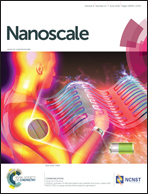Nano-ZnO leads to tubulin macrotube assembly and actin bundling, triggering cytoskeletal catastrophe and cell necrosis†
Abstract
Zinc is a crucial element in biology that plays chief catalytic, structural and protein regulatory roles. Excess cytoplasmic zinc is toxic to cells so there are cell-entry and intracellular buffering mechanisms that control intracellular zinc availability. Tubulin and actin are two zinc-scavenging proteins that are essential components of the cellular cytoskeleton implicated in cell division, migration and cellular architecture maintenance. Here we demonstrate how exposure to different ZnO nanostructures, namely ZnO commercial nanoparticles and custom-made ZnO nanowires, produce acute cytotoxic effects in human keratinocytes (HaCat) and epithelial cells (HeLa) triggering a dose-dependent cell retraction and collapse. We show how engulfed ZnO nanoparticles dissolve intracellularly, triggering actin filament bundling and structural changes in microtubules, transforming these highly dynamic 25 nm diameter polymers into rigid macrotubes of tubulin, severely affecting cell proliferation and survival. Our results demonstrate that nano-ZnO causes acute cytoskeletal collapse that triggers necrosis, followed by a late reactive oxygen species (ROS)-dependent apoptotic process.


 Please wait while we load your content...
Please wait while we load your content...